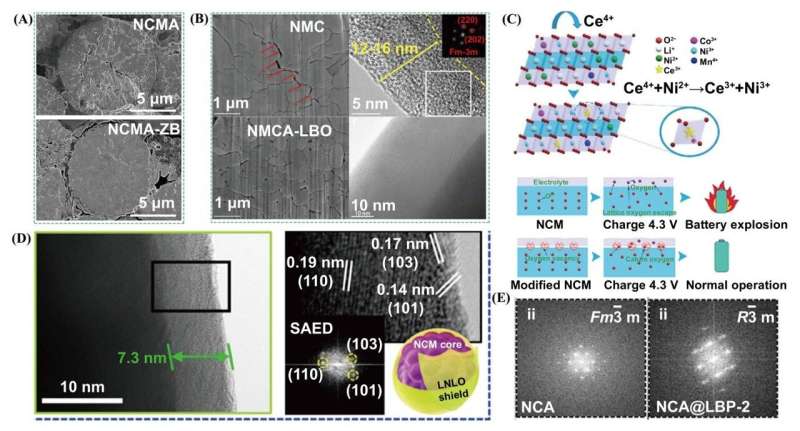Synthesis and surface modification of nickel-rich layered oxide cathode materials for lithium-ion batteries

Lithium-ion batteries (LIBs) scientists from the South China University of Technology have summarized recent progress in surface modification of nickel-rich cathode materials based on the periodic table to provide a clear development of advanced LIBs.
Publishing in the journal International Journal of Extreme Manufacturing, the team sought to further understand how surface modification improves the performance of nickel-rich cathode materials. They have summarized the mechanism of surface modification based on the periodic table for the first time.
The findings could have a widespread impact on the future development of nickel-rich cathode materials. When a new type of nickel-rich material is in contact with these surface modifications, both particles and structures change their configuration in response to the degeneration of the capacity.
Such surface modifications on nickel-rich cathode materials govern the performance of LIBs for clean electricity generation, as well as determining the efficiency of clean energy and underpinning the development of much electronic equipment.
One of the lead researchers, Professor Chenghao Yang, said, "Given the widespread industrial and scientific importance of such behavior, it is truly surprising how much we still have to learn about the mechanism of how modified elements behave on surfaces in contact with the bulk structure. One of the reasons information is missing the absence of techniques able to yield many alternative nickel-rich cathode materials for LIBs."
Surface modification is one of the main techniques that prevent the decomposition of nickel-rich cathode materials from the electrolyte. However, the synthetic processing of nickel-rich cathode materials requires a high-dry environment, and the structure of materials changes in moist air. Professor Chenghao Yang explained, "In this review, we summarized the novel modification technology based on the periodic table in order to provide more designed strategies for surface modification."
A series of nickel-rich cathode materials were synthesized and modified by specific reagent technology. These novel materials were analyzed to show their granular and structural stability.
By analyzing how the modified elements were synthesized on the surface and in the structure and comparing them to the electrochemical performance provided by colleagues at the South China University of Technology, the researchers were able to understand the effect of the modified elements on the high performance of nickel-rich cathode materials for LIBs. The surface modification of the precursor was found to be beneficial for the occupation of the modified elements and also suppress the phase transition with respect to the layered structure of the rock salt phase.
Professor Chenghao Yang said, "This is a milestone achievement and it is only the beginning—we are already looking to use these modifications to support the development of nickel-rich cathode materials for LIBs, needed to achieve the world's net zero ambitions."
More information: Jing Li et al, Recent progress in synthesis and surface modification of nickel-rich layered oxide cathode materials for lithium-ion batteries, International Journal of Extreme Manufacturing (2022). DOI: 10.1088/2631-7990/ac92ef
Provided by International Journal of Extreme Manufacturing




















